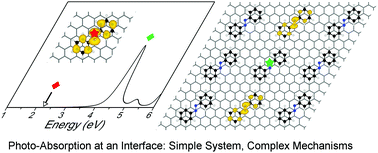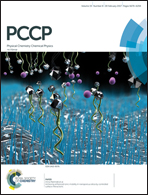Graphene-modulated photo-absorption in adsorbed azobenzene monolayers†
Abstract
The impact of graphene on the photo-absorption properties of trans- and cis-azobenzene monolayers is studied in the framework of density-functional theory and many-body perturbation theory. We find that, despite the weak hybridization between the electronic bands of graphene and those of the azobenzene monolayers, graphene remarkably modulates the absorption spectra of the adsorbates. The excitation energies are affected via two counteracting mechanisms: substrate polarization reduces the band-gap of azobenzene, and enhanced dielectric screening weakens the attractive interaction between electrons and holes. The competition between these two effects gives rise to an overall blueshift of peaks stemming from intramolecular excitations, and a redshift of peaks from intermolecular ones. Even more interesting is that excitations corresponding to intermolecular electron–hole pairs, which are dark in the isolated monolayers, are activated by the graphene substrate. Our results demonstrate that the photoisomerization process of weakly adsorbed azobenzene undergoes notable changes on a carbon-based substrate.



 Please wait while we load your content...
Please wait while we load your content...